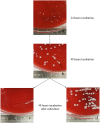Clinical characteristics and outcomes of prosthetic joint infection caused by small colony variant staphylococci
- PMID: 25271290
- PMCID: PMC4196237
- DOI: 10.1128/mBio.01910-14
Clinical characteristics and outcomes of prosthetic joint infection caused by small colony variant staphylococci
Abstract
Small colony variants (SCVs) are naturally occurring subpopulations of bacteria. The clinical characteristics and treatment outcomes of patients with prosthetic joint infection (PJI) caused by staphylococcal SCVs are unknown. This study was a retrospective series of 113 patients with staphylococcal PJI, with prospective testing of archived sonicate fluid samples. SCVs were defined using two-investigator review. Treatment failure was defined as (i) subsequent revision surgery for any reason, (ii) PJI after the index surgery, (iii) prosthesis nonreimplantation due to ongoing infection, or (iv) amputation of the affected limb. There were 38 subjects (34%) with SCVs and 75 (66%) with only normal-phenotype (NP) bacteria. Subjects with SCVs were more likely to have been on chronic antimicrobials prior to surgery (P = 0.048), have had prior surgery for PJI (P = 0.03), have had a longer duration of symptoms (P = 0.0003), and have had a longer time since joint implantation (P = 0.007), compared to those with only NP bacteria. Over a median follow-up of 30.6 months, 9 subjects (24%) with SCVs and 23 (32%) with only NP bacteria experienced treatment failure (P = 0.51). Subjects infected with Staphylococcus aureus were more likely to fail than were those infected with Staphylococcus epidermidis (hazard ratio [HR], 4.03; 95% confidence interval [CI], 1.80 to 9.04). While frequently identified in subjects with PJI and associated with several potential predisposing factors, SCVs were not associated with excess treatment failure compared to NP infections in this study, where they were primarily managed with two-stage arthroplasty exchange.
Importance: Bacteria with the small colony variant (SCV) phenotype are described in small case series as causing persistent or relapsing infection, but there are insufficient data to suggest that they should be managed differently than infection with normal-phenotype bacteria. In an effort to investigate the clinical importance of this phenotype, we determined whether SCVs were present in biofilms dislodged from the surfaces of arthroplasties of patients with staphylococcal prosthetic joint infection and assessed the clinical outcomes associated with detection of SCVs. We found that prosthetic joint infection caused by SCV staphylococci was associated with a longer duration of symptoms and more prior treatment for infection but not with an increased rate of treatment failure, compared to infection caused by normal-phenotype staphylococci.
Copyright © 2014 Tande et al.
Figures



References
-
- Tsaras G, Osmon DR, Mabry T, Lahr B, St. Sauveur J, Yawn B, Kurland R, Berbari EF. 2012. Incidence, secular trends, and outcomes of prosthetic joint infection: a population-based study, Olmsted county, Minnesota, 1969-2007. Infect. Control Hosp. Epidemiol. 33:1207–1212. 10.1086/668421 - DOI - PMC - PubMed
Publication types
MeSH terms
Grants and funding
LinkOut - more resources
Full Text Sources
Other Literature Sources
Molecular Biology Databases
Miscellaneous

